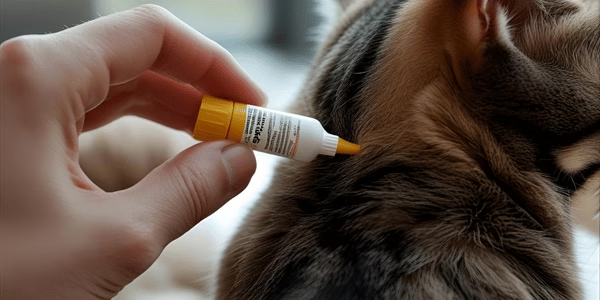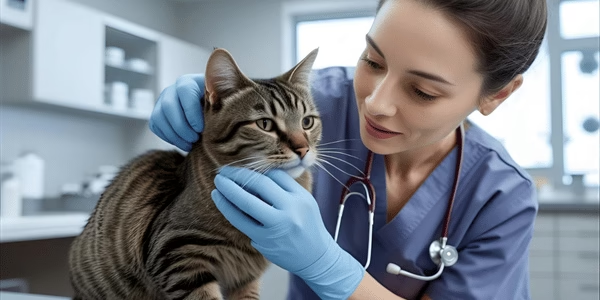Ever watched your cat dart across the living room floor like a tiny tiger, only to stop and scratch at her neck like she’s auditioning for a flea commercial? Not exactly what you signed up for when you brought that ball of fluff home, right? Listen, keeping your cat free from parasites can feel more confusing than finding a new series to binge. But believe me, once you know what to look for and do, it’s WAY easier than you think, and it makes life a whole lot more pleasant (for both of you).
Whether you’re a brand-new cat parent or you’ve been owned by cats for years (yes, we know who’s boss), this is the most practical, no-nonsense cat parasite prevention guide you’re going to find. Why? Because I actually want your cat to be healthy AND for you to skip all the stress and guesswork.
Let’s break down everything you need to know, no fluff, no drama. Just straight talk for real cat people who want real answers.
Why Cat Parasite Prevention Isn’t Optional
I know what you might be thinking: “My cat’s an indoor cat. She sleeps in sunbeams, not mud puddles. Why should I even care about parasites?”
Here’s the harsh reality: even if you keep your home cleaner than a Pinterest kitchen and your cat hasn’t seen the backyard since the day you brought her home, parasites can STILL make their way in. Shoes, grocery bags, other pets, open windows, the little suckers don’t care how neat you are or what your zip code is. And if you skip prevention? Sooner or later, you’re rolling the dice with your cat’s comfort and your own peace of mind.
So, forget the old myths about “safe” indoor cats. If you want to avoid late-night emergencies, expensive vet bills, and that feeling of defeat when you spot a flea on your white duvet, prevention is where it’s at.
Meet the Enemy: Common Cat Parasites and Why You Should Care
Nobody wants to talk about parasites at dinner, but if you love your cat (and your carpets), you need to know what you’re up against. Because it isn’t just about itchy skin, the risks run a whole lot deeper.
Here’s a quick intro to your feline’s most likely enemies:
Fleas: The Devil in Disguise
Fleas are the classic cat parasite. Trust me, you never want to deal with them once they’ve set up shop. These tiny bloodsuckers can turn your chill, purring cat into a scratching, miserable mess. But that’s not even the worst part: fleas aren’t just annoying. They can cause skin infections, allergic reactions, anemia (especially in kittens), and even give your cat tapeworms. Yep, fleas have got range, and NONE of it is good.
Ticks: The Underdog You Forgot To Worry About
Most folks freak out about ticks on dogs (understandable), but guess what? Ticks dig cats, too. You might not spot them very often, but when you do, remove them ASAP. Ticks can transmit some nasty illnesses, stuff like bobcat fever, Lyme disease (rare but possible for cats), and plenty more that sound like something you’d see in a disaster movie. Always better to prevent than try to fix.
Worms: More Than Just a Gross Word
Roundworms, hookworms, and tapeworms don’t care how fancy your cat’s food is, if they get in, they’re going to make themselves right at home inside your cat’s gut. You might notice vomiting, diarrhea, weight loss, or just a general “something’s not right” vibe. With kittens, the risk is even worse, worms can literally kill or stunt their growth. Not a gamble worth taking.
Ear Mites and Friends: The Ultimate Annoyance
The good news? Ear mites are rarely deadly. The bad? They itch like crazy and can lead to ear infections or intense head shaking that’ll scratch up your furniture AND your nerves. If your cat’s ears look waxy, red, or she’s shaking her head endlessly, don’t ignore it.
Heartworm: The Silent Threat
You’ve probably heard about heartworm in dogs, but did you know cats CAN get heartworm, too? It’s less common, sure, but when it hits, it hits hard. There’s no real cure for heartworm in cats (seriously), so prevention isn’t just smart, it’s essential.
Protozoa: The Tiny Trouble-Makers
Giardia, toxoplasma, and other microscopic menaces can sneak into your cat from contaminated soil or food. Sometimes your furry friend pulls through with just a tummy ache, but these parasites can cause dehydration, chronic diarrhea, or even pass risks to humans, especially pregnant women or immune-compromised people. That’s not the kind of surprise you want.
The Bigger Picture: Parasites Don’t Just Hurt Your Cat
It’s easy to assume parasites are just your cat’s problem, but here’s the kicker, they can cause chaos for the whole household. When you let things slide, you’re inviting bigger issues:
- Zoonotic infections: Yeah, you can catch some of these from your cat, especially toxoplasmosis and roundworms.
- Allergies and asthma: Flea bites and dander from infested cats can make these way worse.
- Home infestations: Ever tried getting rid of a flea infestation in your house? Imagine summer, but instead of sun, you get itchy ankles. Hard pass.
Bottom line: parasite prevention for cats is family prevention, including you, your kids, and even Uncle Bob who only visits at Thanksgiving.
Prevention: It’s NOT Complicated, If You Know What Works
Here’s the core truth: preventing parasites is a million times easier (and cheaper) than getting rid of them once they’ve moved in. Don’t wait for the first scratch or the “Is that a worm?!” moment. Be proactive, not reactive.
Start Young, Stay Consistent
If you’ve got a kitten, don’t wait. De-worming and first preventive treatments should start as early as two weeks old. I know, it sounds wild, but kittens are parasite magnets and MUCH more likely to get really sick from an infestation.
For adult cats, regular treatments are non-negotiable. Don’t play the “I’ll watch for signs” game, many cats hide symptoms like Olympic athletes until things are REALLY bad. Set up a routine and stick to it.
Home Hygiene is Your Secret Weapon
Even the fanciest spot-on treatment can’t keep fleas from setting up a tiny flea-coast resort in your carpets if you don’t keep things clean. Here’s what actually works:
- Vacuum often, especially in your cat’s favorite haunts (yes, under the bed too).
- Wash bedding at high temperatures, think of it as a flea sauna.
- Clean litter boxes daily and toss the old litter instead of trying to top it off.
- Seal up outdoor sandboxes or dirt patches unless you want a worm breeding ground.
Trust me, a little extra effort here saves you from fighting a full-scale insect invasion later. No one wants that.
Don’t Forget the Environment
Parasites don’t just jump onto your cat, they linger in the environment. That means flea eggs, larvae, and worm eggs can hang around waiting to start trouble, especially if you slack on cleaning. If you’ve ever found yourself battling a never-ending flea cycle, it’s almost ALWAYS because of missed steps with the home.
Vacuum. Mop. Pick up stray fur. I know it’s not glamorous, but it works.
Pick the Right Prevention Products (And Don’t “DIY” It)
This one’s critical. Walk down any pet store aisle and you’ll find enough flea collars, sprays, spot-ons, and “miracle” treatments to make your head spin. Here’s the uncomfortable truth: not all of them work, and some of them can put your cat in real danger.
Don’t grab the cheapest thing because it’s on sale and DEFINITELY don’t use dog products on your cat. Some dog flea meds are deadly for felines. Read that again: DEADLY. You don’t want to learn that the hard way.
Instead, call your vet. Ask what they recommend. Some of the best options these days are topical treatments that cover multiple parasites (fleas, ticks, worms) and need to be re-applied just once a month or so. Sure, they cost more than grocery store stuff, but how much is your cat’s comfort and health worth, really?
If you must buy over-the-counter, stick to recognized brands and double-check active ingredients. Permethrin, for example, is great for dogs and HORRIBLE for cats. If you’re not sure, don’t risk it.
Real Talk: How to Choose Parasite Prevention That Works
Every cat is different. What works brilliantly for your neighbor’s ginger tabby might be wrong for your grumpy Maine Coon. Here’s how to keep the confusion (and the “did I buy the right thing?” anxiety) to a minimum.
Get Vet Advice, Even if Your Cat “Seems Fine”
Your vet isn’t just there for emergencies or when your cat eats a spider plant and pukes on your favorite hoodie. A good vet can recommend the best combo of treatments for your cat’s breed, health, age, and whether she’s a solo sofa-dweller or an outdoor adventurer. They can answer the tough questions: Does your cat need heartworm prevention? What about a multi-cat household? Are there better products if your cat hates being handled? Let them help you take out the guesswork.
Read the Label, Twice
I’ve seen too many well-meaning cat parents accidentally poison their cats because they assumed “If it works for dogs, it’ll work for cats.” Please don’t be that person. Cats have unique metabolisms, and some common ingredients in dog products are downright lethal for felines.
So, flip every box and bottle. Look for words like “for cats only.” If you’re not 100% sure, ask your vet or pharmacist.
Know What You’re Treating For
Most of the top products are made to handle more than one parasite. Some cover fleas and ticks, while others add in worms or even ear mites. The very best products are usually prescription-only, and, honestly, worth every cent. Think of it as insurance against your cat and your sanity going down the drain.
Here’s a sample breakdown:
- Spot-ons like selamectin and moxidectin handle fleas, some worms, and ticks.
- Fluralaner-based topicals can give you longer coverage, some even stretch protection to 8–12 weeks.
- Dewormers (pyrantel, praziquantel) are usually for roundworms, hookworms, and tapeworms, but always check as not all cover every worm.
Pro tip? Sometimes you need to layer preventatives or rotate based on your vet’s advice, especially if your cat goes outdoors or you live in a heavy-flea zone.
Setting Up Your Cat’s Parasite Prevention Plan
A little structure goes a long way, so here’s how to take anything-but-heroic measures and still win the parasite war.
Step 1: Start with Your Vet
A single appointment can set your mind at ease, plus you’ll get specific recommendations for your cat, no guesswork required. Ask about which products to use, frequency, and any special tweaks for your cat’s lifestyle or age.
Step 2: Create a Calendar Reminder
Don’t trust yourself to remember to re-dose every four weeks? Neither do I. Set up calendar notifications, phone, email, sticky notes, whatever works. Consistency is the only way to win.
Step 3: Monitor for Signs
Check your cat’s coat and ears for irritation, bald spots, or weird gunk. Keep an eye out for unusual poops, vomiting, or weight loss. Be nosy, catching problems early means much less drama later.
Step 4: Clean, Clean, Clean
Don’t just treat the cat, treat the house. Wash bedding weekly, vacuum every couple of days, and keep that litter box spotless. You know all that “extra” cleaning you sometimes put off? When you have pets, it pays off big time.
Step 5: Follow Up with Annual Vet Visits
Even if your cat seems fine, a yearly trip to the vet keeps you ahead of hidden problems. Many parasites are experts at lurking undetected. Annual fecal samples, wellness exams, and updated prevention guidance can literally save lives (and money).
Quick-Action Parasite Prevention Checklist
Let’s be honest. No article can turn you into a cat health wizard overnight, but you can cover your bases with a few quick, repeatable habits:
- Book a yearly vet wellness exam, including a parasite check.
- Treat your cat monthly with a vet-recommended product.
- Clean your cat’s bedding and favorite chill spots every week.
- Vacuum more than you think is necessary.
- Don’t skip the litter box (your whole house will thank you).
- Say no to sketchy, “all-natural” parasite fixes.
No, it’s not glamorous work. But when you and your cat flick on Netflix, pest-free, you’ll know it was worth it.
Bonus: Putting It All Together for Multi-Cat Homes
More than one cat? Your job isn’t just double, it’s exponential. Why? Because parasites can hop from cat to cat, leading to never-ending cycles of misery.
Here’s how to keep your feline crew protected without losing your mind:
- Treat everyone at the same time (no exceptions, even the one that hides under the couch).
- Keep to a strict cleaning routine (seriously, vacuuming is underrated).
- Keep up communication with your vet if any of your cats have health issues or you get a sudden infestation.
Remember, the goal isn’t just to react, it’s to stay ahead. Cats are counting on you, after all.
Final Thoughts: The Preventive Edge
So, here’s the deal. Parasite prevention for cats isn’t some wild, time-consuming mission you need a Ph.D. to pull off. With a plan, a vet on speed dial, and a willingness to stick to the basics, you’ll dodge most problems before they start.
Don’t let anyone tell you that “indoor cats don’t need this” or “flea collars are enough.” The modern world, and modern parasites, are always one step ahead. So beat them at their own game: clean home, smart products, and regular check-ins.
You’ve got this. Your cat deserves to be healthy, comfortable, and unbothered by bugs and worms. Trust me, you’ll sleep better, and so will your favorite feline nap expert.
Ready to get started? Treat your cat, clean your house, and make parasite worries a thing of the past.
Realities & Myths: Parasite Prevention FAQ
Do indoor cats REALLY need prevention?
Yes, yes, and yes. Indoor cats catch parasites all the time, fleas hitch rides on shoes, worms worm their way in from soil, and ticks are sneaky. Don’t risk it.
Can I catch something from my cat?
Unfortunately, yes, especially roundworms and toxoplasma. Practice good hygiene (wash those hands!), keep up on vet visits, and you’ll lower the risk big time.
Is it OK to use home remedies or natural treatments?
Short answer: Just don’t. Sure, there are natural options out there, but most don’t work (no, diatomaceous earth is not a magic fix), and some can even harm your cat. Stick to what’s tested and proven.
How often should I treat my cat?
Most adult cats need a broad-spectrum parasite preventative every 4 weeks (monthly), plus a de-wormer every 3 months. For kittens? Go even more frequent until they’re six months old, ask your vet for the best schedule.
What if I see worms or fleas, even with prevention?
Call your vet immediately. Sometimes resistance happens or infestations get out of control fast. You need a targeted plan and possibly prescription meds to break the cycle.








